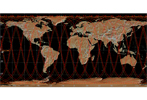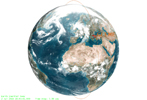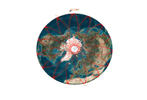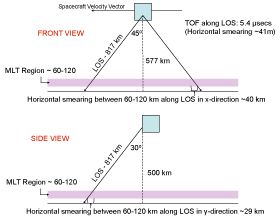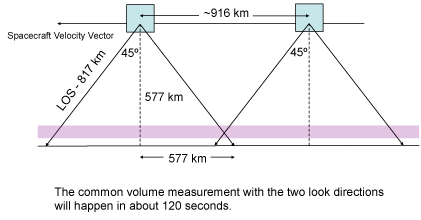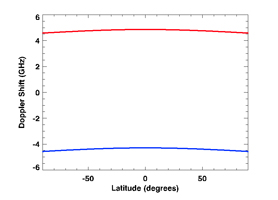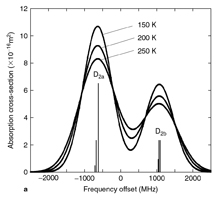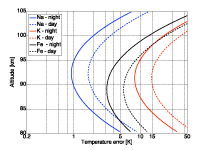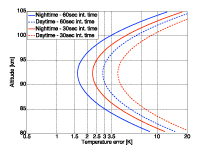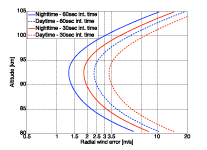This mission concept is motivated by the outstanding mesospheric science questions that only a high resolution and accuracy instrument such as a lidar can provide. These include issues in mesospheric chemistry and composition, transport phenomena, noctilucent clouds (NLCs), metallic layers and meteoric dust, and most importantly small scale waves.
Preliminary Mission Design
Our preliminary choice of orbit balances power and coverage both over topography and over the polar regions.
top
Viewing Geometry
We develop a novel measurement scheme uses two orthogonal look directions offset ~30° from nadir and the satellite motion to provide common volume measurements with two orthogonal lines of sights for the decomposition of vector horizontal winds. This obtains high temporal and spatial resolution horizontal winds and temperatures.
top
Doppler Shifts
Significant complications for a spaceborne resonance fluorescence lidar are the Doppler shifts associated with the spacecraft frame-of-reference relative to the Earth’s. which may be split into two effects: Doppler Shift due to spacecraft motion and Doppler Shift due to Earth’s rotation. The combined effect of the shifts adds significant requirements to the laser transmitter subsystem, as well as to the receiver. The effects are presented here. The effective Na line frequencies are varying functions of latitude and are displaced by ~9GHz between the fore and aft looking telescopes.
top
Measurement concept
In order to resolve both temperature and wind measurements, the two frequency technique is not sufficient. Typically a three frequency technique displaced evenly about the D2a peak at offsets of ±630 MHz is used.
top
Preliminary Error Analysis
We calculated the errors that we would expect for retrievals of temperature and LOS wind in the core mesosphere region and determined that Na is the optimal choice for this lidar mission.
Our preliminary error analysis shows temperature, wind, and sodium density at high enough resolution to obtain a significant part of the gravity wave spectrum.
top
Summary
We have developed a preliminary design for a spaceborne, LEO mesosphere lidar mission that will study gravity waves and their effects on the mean state and variability. We demonstrate that sodium is the optimal choice for this lidar to obtain high enough temporal and spatial resolution. Significant trade-offs may be required in terms of integration time (spatial resolution) and the instrument design.
| Preliminary GLEME lidar parameters |
| Wavelengths |
λ0 = 589.16 nm (vacuum)
λ1,4 = λ0 ± 5 GHz
λ2,3 = λ0 ± 5 GHz ± 630 MHz
λ5,6 = λ0 ± 5 GHz ± 630 MHz |
| Pulse energy |
50 mJ |
| Pulse Repetition Rate |
33 Hz (3 frequencies) |
| Average optical power |
5 Watts |
| Average electrical power consumption |
500 Watts |
top
